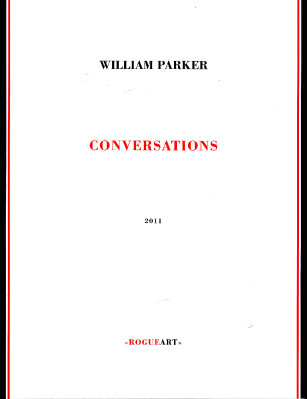
William Parker: Conversations (Rogueart)
"The memories that stop being memories due to constant use."- Laurie Anderson
"Beauty is a puppet that keeps dangling in front of me." - Anselm Keifer
Not since John Zorn’s Arcana project and Art Taylor's Notes and Tones, a comparison many will make, and which Parker says in his brief intro is the book that inspired him to do this project, has there been a book of interviews so vital, so down to earth and so personal. What we have here are 34 interviews conducted by Parker over approximately the last decade, 30 of which are with so-called free jazzers/improvisers, two with new music composers, one with Patricia Nicholson Parker (his wife, a dancer and an organizer of such events as the ongoing Vision Festival), and one with photographer Jacques Bisceglia who also contributed a beautiful black and white and color centerfold (27 photos) of most of the artists being interviewed.
Though primarily known as an independent cd label out of Paris, France, Rogueart has thus far published three books, the two just mentioned and another, Logos and Language, a collaboration by pianist Matthew Shipp and me. I also had the privilege of collaborating with Bisceglia on another Rogueart project, Reaching into the Unknown (2009).
As Parker points out, these talks represent "oral histories" by artists who have dealt in/with the creative process and all its joys, hardships, knowledge, and discoveries. He states that one necessity for this collection is to bring these artists more out of the realms of myth and more into the realms of reality. Their range runs the gamut of the known to the lesser known to the almost obscure, and hopefully one thing this book will do is familiarize people with their lives and make them want to go out and hear their ART.
We are also fortunate enough to have interviews with musicians who only just recently left us, such as Billy Bang and Fred Anderson, and those like Frank Lowe who departed a few years back and whom Parker got to interview at his hospital bed while he was dying. Lowe quoting Don Cherry says, "You got to be in tune no matter whether it's going outside, inside, crossways or down." He then goes on to say when you are "doing a solo you’re the only one… but at the same time there's power in numbers…a group situation helps to sustain you" and that if “you felt it, you played what you felt. You don't ask about the feelings you just play [them.]” Lowe again: “We are always copying someone…when you see that you have to change up fast.” This is so true for all arts.
The book encompasses many of the first wave of the avant-garde players, including Dave Burrell, Sonny Murray, Alan Silva, and Milford Graves, who states that it’s about what we smell, taste and hear…the sound spectrum…frequency spectrum. Not to recall the same note…to adjust to the vibration and that a musician’s job is to be the receptor of the vibrations of the planet. What we continually learn from these masters, sometimes quite poignantly, is their intense struggles, their complete devotion to their art and why they do what they do. Cooper Moore puts it this way.
"Music gives people great relief…that's why I do it."
What we constantly see is how these artists grew up thrived, learned about and got into their crafts, their fundamental ideas about the music and how they came to play it and/or arrived at their process, or as i tnhe case of Patricia N. Parker and Bisceglia, how they came to play an active role in the “scene.”
Billy Bang, a Vietnam veteran, talks about growing up in Harlem and how his time in Vietnam affected both him and his music (later in life, Billy made two CDs based on his experiences there and used musicians who had also served there). "Vietnam has been such a big influence on me…that’s why I dedicated myself to music." Parker at one point says after hearing the horrific stuff Bang went through, "Those people who sent anybody there should be locked up," to which Billy readily agrees. When Bang talks about why/how he plays the violin, he states that besides the human voice, the violin is an early instrument and that rather than try to become a unique voice on it he decided to dedicate and commit himself to investigate this area and the instrument’s range and tradition.
Each interview is prefaced with a beautiful take by Parker on the musician he will speak to, always asking the question 'why do you do this?' One reply by Chinese composer Ge Gan-ru is simply, "I don't know... but this I do know I cannot live without the music."
The interviews are of varying lengths, as short as eight pages and as long twenty, and as editor Ed Hazell points out, "were edited for clarity…but the goal was to maintain the character of the musicians' voices."
The accompanying CD contains 45 short tracks containing snippets of the interviewees interspersed with short solo bass pieces by Parker.
This is both a learning and survival manual, or as Parker puts it, "everyone has a story that is part of the continuum…a small piece of the puzzle that is creativity." So if you want to educate yourself a bit more, pick up this book, listen to these 34 songs from cover to cover, then turn the pages and listen some more to the “sound, movement and color” that comes deep out of the well of creativity. And each time you’ll hear (read) something fresh, different, and new. Sound is a very personal thing, and there is a wealth of knowledge to be absorbed, digested, and learned from all these unique individuals, their unrestrained voices, and the candid music of their language, emotions, and thought.
